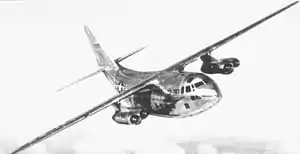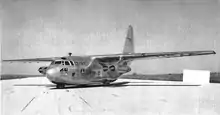Chase XC-123A
The Chase XC-123A was an experimental transport aircraft developed by Chase Aircraft. The first jet-powered transport built for the United States Air Force, it was intended for use as a high-speed transport for high-priority cargo and personnel. The XC-123A was determined to have insufficient advantages over existing types in service, and did not go into production. The sole prototype was converted into the piston-powered Stroukoff YC-123D to evaluate boundary layer control systems.
| XC-123A | |
|---|---|
 | |
| Role | Military transport aircraft |
| Manufacturer | Chase Aircraft |
| Designer | Michael Stroukoff |
| First flight | 21 April 1951 |
| Primary user | United States Air Force |
| Number built | 1 |
| Developed from | Chase XCG-20 |
| Career | |
| Other name(s) | Jet Avitruc |
| Serial | 47-787 |
| Fate | Converted to YC-123D 53-8068 |
Design and development
In the late 1940s, Chase Aircraft had developed the XG-20, the largest glider ever built in the United States.[1] By the time it was ready for operations, however, U.S. military doctrine had been altered to remove the requirement for the use of transport gliders in combat.[2]
However, the XG-20's aircraft had been designed to allow for the easy installation of power plants, and Chase modified the two prototypes into powered aircraft, one becoming the XC-123, with twin piston engines.[3] The second XG-20, however, was taken in hand for a more radical reconfiguration, being fitted with two twin-jet engine pods, of the type used by the Convair B-36 and Boeing B-47 bombers, to become the XC-123A.[4] As there was no provision for housing fuel in the former glider's wings, fuel tanks were installed underneath the cabin floor.[4]
Operational history
Dubbed "Avitruc" by its manufacturer,[5] the XC-123A conducted its maiden flight on April 21, 1951,[4] becoming the first jet-powered transport aircraft to successfully fly in the United States.[4] It was considered "excellent" in flight trials, with the aircraft showing few vices,[6] and demonstrating reasonably good short-field capability.[4]
Despite this, even as the XC-123 proved successful, the XC-123A failed to win sufficient favor in flight testing to receive a production order. Although the aircraft's short-field performance was good, on rough, unimproved fields the low-slung jet pods would suck debris into the intakes, damaging the engines.[4] In addition, the aircraft's design was mismatched to its engines,[7] resulting in the XC-123A being incapable of providing sufficient cargo capacity compared to the amount of fuel its jet engines required.[2] As a result, the XC-123A project was abandoned without additional aircraft being built.[2]
Following the conclusion of trials, the XC-123A was converted to be powered by two Pratt & Whitney R-2800 radial engines, and was used for boundary layer control trials as the Stroukoff YC-123D, receiving serial number 53–8068.[4][8][9]
Specifications (XC-123A)

Data from Gunston[6] and Adcock[4]
General characteristics
- Crew: 3
- Length: 77 ft 1 in (23.50 m)
- Wingspan: 110 ft 0 in (33.53 m)
- Height: 33 ft 10 in (10.31 m)
- Wing area: 1,222.78 sq ft (113.600 m2)
- Airfoil: NACA 23017[10]
- Empty weight: 25,000 lb (11,340 kg)
- Max takeoff weight: 60,000 lb (27,216 kg)
- Powerplant: 4 × General Electric J47-GE-11 turbojets, 5,200 lbf (23 kN) thrust each
Performance
- Maximum speed: 500 mph (800 km/h, 430 kn)
- Cruise speed: 400 mph (640 km/h, 350 kn)
See also
Related development
Aircraft of comparable role, configuration, and era
Related lists
References
- Notes
- Sergievsky et al. 1998, p.128
- Mitchell 1992, p.164.
- Adcock 1992, p.4.
- Adcock 1992, p.7.
- Air League 1975, p. 113.
- Gunston (ed.) 1980
- Sweetman 1979, p.97.
- Baugher 2010a
- Baugher 2010b
- Lednicer 2010
- Bibliography
- Adcock, Al (1992). C-123 Provider in action. Aircraft In Action. 124. Carrollton, TX: Squadron/Signal Publications. ISBN 978-0-89747-276-0.
- Air League (1975). "Chase XC-123A". Air Pictorial. London: Air League of the British Empire. 37: 113.
- Baugher, Joe (2010). "1946-1948 USAAF Serial Numbers". USAAS-USAAC-USAAF-USAF Aircraft Serial Numbers--1908 to Present. Retrieved 2010-11-28.
- Baugher, Joe (2010). "1953 USAAF Serial Numbers". USAAS-USAAC-USAAF-USAF Aircraft Serial Numbers--1908 to Present. Retrieved 2011-01-22.
- Gunston, Bill, ed. (1980). The Illustrated Encyclopedia of Commercial Aircraft. New York: Exeter Books. ISBN 978-0-89673-077-9.
- Lednicer, David (2010). "The Incomplete Guide to Airfoil Usage". University of Illinois at Urbana-Champaign. Archived from the original on 2010-04-20. Retrieved 2010-11-27.
- Mitchell, Kent A. (1992). "The C-123 Provider". AAHS Journal. Santa Ana, CA: American Aviation Historical Society. 37. Retrieved 2010-11-28.
- Sweetman, William (1979). A History of Passenger Aircraft. London: W.H. Smith/Hamlyn Publishing Group. ISBN 978-0-600-37248-6.
External links
| Wikimedia Commons has media related to Chase XC-123A. |
- Bonnier Corporation (July 1951). "Jet Power Troop Transport". Popular Science. Bonnier Corporation. p. 81.